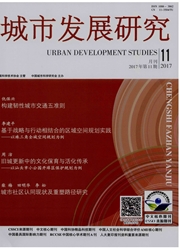

 中文摘要:
中文摘要:
几个世纪以来城市群的发展都备受关注,其焦点也从发达国家的大都市带逐渐转移到发展中国家的新兴城市群.许多研究认为,全球化已经成为发展中国家沿海地区城市群形成的重要因素,如中国沿海的珠江三角洲、长江三角洲和京津冀区域.然而,随着中国“发展内需”策略的提出,尤其是2008年全球经济危机之后,在中国中央政府和地方政府的规划和积极推动下,中国内陆地区出现了新的城市群.它们的发展特征和机制是否与沿海地区的城市群一致呢?在这样的一个背景下,以长株潭城市群为例,考察了内陆城市群的发展特征及其动力机制.研究发现该区域经历了巨大的经济增长结构转变和适度的城市化进程,反映出“自上而下”的政府强有力的指导.通过固定效应模型,研究认为相比于沿海地区“外力”对其城市化的驱动作用,国家“发展内需”策略下所产生的“内力”对中国内陆地区的城市化起着更为重要的作用.
 英文摘要:
英文摘要:
The development of Extended Metropolitan Regions (some scholar call it urban cluster in China) has attracted attention for centuries. Many such studies have concluded that globalisation has been one of the most important factors for the emergence of urban clusters in coastal areas of the less developed countries (LDCs). However, along with the promotion of China's domestic demand strategy, there are newly emerged urban clusters in Interior China that are planned and promoted by its central and local governments. This study, using the Changzhutan urban cluster as a ease, examines the specific features of such newly formed urban cluster and its growth mechanism. The region has undergone dramatic economic growth structural transformations and a moderate-speed urbanisation process which manifested strong direction of the governments. Through the Fixed-effects Model, the paper argues that new urbanisation trend in Interior China is more embedded in local forces arising from the nation's new development strategy of emphasizing domestic demand.
 同期刊论文项目
同期刊论文项目
 同项目期刊论文
同项目期刊论文
 A new pattern of Extended Metropolitan Regions (EMRs) in China: A case study in the Changzhutan (CZT
A new pattern of Extended Metropolitan Regions (EMRs) in China: A case study in the Changzhutan (CZT 期刊信息
期刊信息
